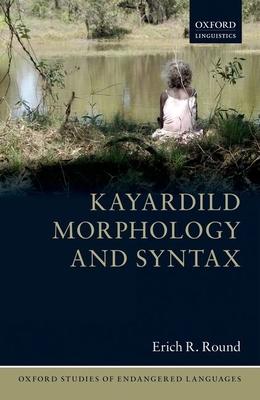This book presents new data and a formal analysis of the inflectional system and syntax of Kayardild, a typologically striking language of Northern Australia. It sets forth arguments for recognizing an intricate syntactic structure that underlies the exuberant distribution of inflectional features throughout the clause, and for an intermediate, 'morphomic' level of representation that mediates morphosyntactic features' realization as morphological forms.
The book differs from existing treatments of Kayardild in unifying the explanation of shared morphological exponents, positing a detailed, empirically-grounded underlying syntax, identifying new clausal and nominal structures, simplifying the analysis of Kayardild's dual tense system, rejecting an analysis according to which some case markers are morphologically 'verbalizing' and some tense markers 'nominalizing', and arguing that upper bounds on syntactic complexity are inherently syntactic rather than derivative of constraints on morphology.
Analyses are expressed formally in terms of syntactic structures and morphosyntactic features which will be interpretable to a broad range of theories. Early chapters provide overviews of Kayardild phonology and morphological structure in general, and a final chapter implements the analysis in constraint-based grammar. Example sentences are glossed across four or five lines, furnishing explicit analyses at multiple levels of representation, and an appendix gathers over one hundred examples sentences to provide large-scale empirical support for the syntactic analysis of tense inflection.
| FindBook |
有 1 項符合
Kayardild Morphology and Syntax的圖書 |
 |
Kayardild Morphology and Syntax 作者:Round,Erich R. 出版社:Oxford Univ Pr 出版日期:2013-02-07 語言:英文 規格:精裝 / 295頁 / 15.9 x 23.5 x 1.9 cm / 普通級 |
| 圖書館借閱 |
| 國家圖書館 | 全國圖書書目資訊網 | 國立公共資訊圖書館 | 電子書服務平台 | MetaCat 跨館整合查詢 |
| 臺北市立圖書館 | 新北市立圖書館 | 基隆市公共圖書館 | 桃園市立圖書館 | 新竹縣公共圖書館 |
| 苗栗縣立圖書館 | 臺中市立圖書館 | 彰化縣公共圖書館 | 南投縣文化局 | 雲林縣公共圖書館 |
| 嘉義縣圖書館 | 臺南市立圖書館 | 高雄市立圖書館 | 屏東縣公共圖書館 | 宜蘭縣公共圖書館 |
| 花蓮縣文化局 | 臺東縣文化處 |
|
|
圖書介紹 - 資料來源:博客來 評分:
圖書名稱:Kayardild Morphology and Syntax
內容簡介
作者簡介
Having spent nine months in the field with the last speakers of Kayardild, Erich R. Round received his doctorate from Yale University in 2009 and completed a post-doctoral appointment at Yale in 2011. He is now Lecturer in Linguistics at the University of Queensland, Australia, where he continues his research on typological and theoretical morphology and phonology.
|











